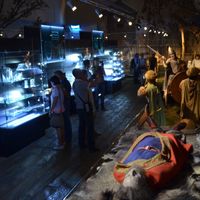Trzcinica
6.6

Overview
Trzcinica is a village in the Podkarpackie Voivodeship, known for its rich history and unique monuments. Located in the Obniżenie Gorlickie valley on the Ropa River, it is a site of archaeological discoveries and is often called the "Troja Północy" (Trojan Horse of the North). Its history dates back to the early Bronze Age, and archaeological excavations confirm the presence of fortified settlements as early as 2100–1650 BCE. Trzcinica is home to the Karpacka Troja archaeological open-air museum, which attracts both tourists and researchers.
The village's architecture is represented by the historic Church of St. Doroty from the late 15th century, renowned for its valuable Renaissance and Mannerist polychromes. Also noteworthy is the 19th-century manor complex, which includes elegant outbuildings and a park. Trzcinica plays an important cultural role, with active folk groups such as "Trzcinicoki" and the International Festival of Carpathian Folklore. The village also has a school with a long tradition dating back to the 16th century, offering education in various fields, including secondary school programs.
Various folk traditions and rituals have been preserved in Trzcinica, contributing to its unique character. An interesting fact is that in 2014, residents planted an oak tree—the "Oak of Freedom"—to celebrate the 25th anniversary of freedom in Poland. The village's administrative history is rich, spanning from the times of the Polish Crown, through the Austrian partitions, to the modern era, when Trzcinica became part of the Jasło municipality.
The village has an agricultural character, and residential development mainly took place in the second half of the 20th century. It is a place that combines a rich history, unique architecture, active cultural life, and natural attractions, making it appealing to both residents and tourists.
Location
You can also find here:
2025 Wizytor | All Rights Reserved
